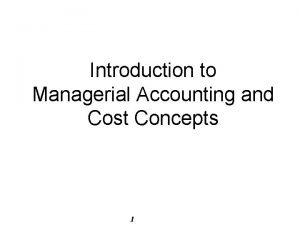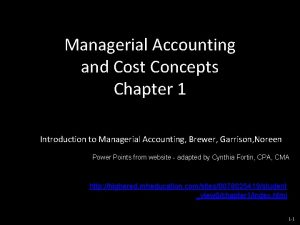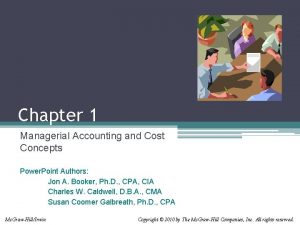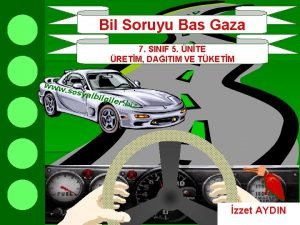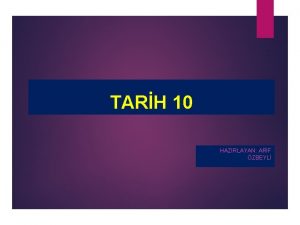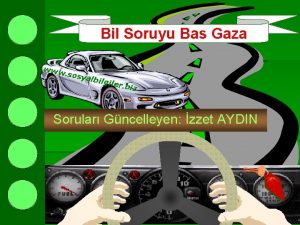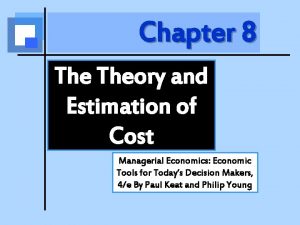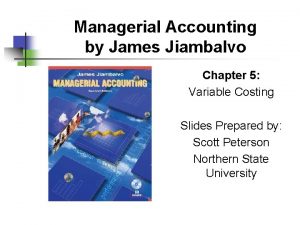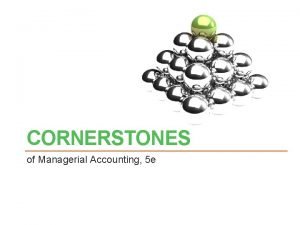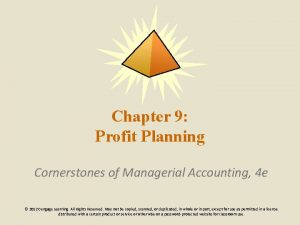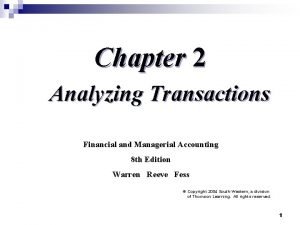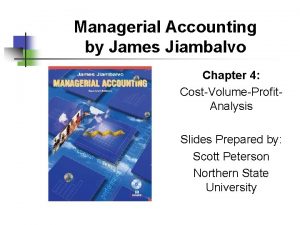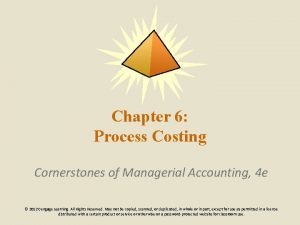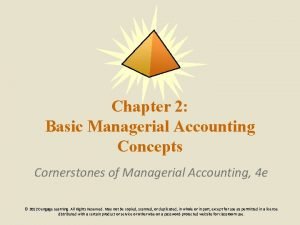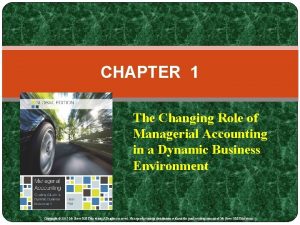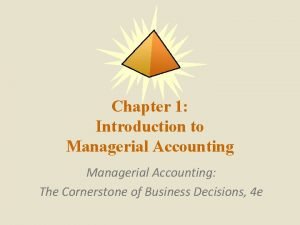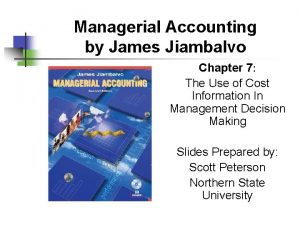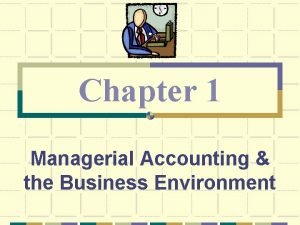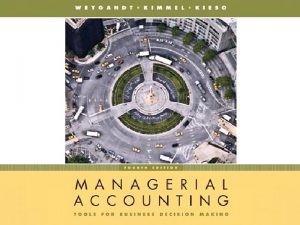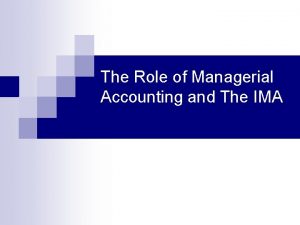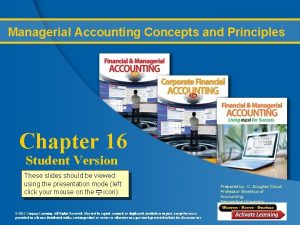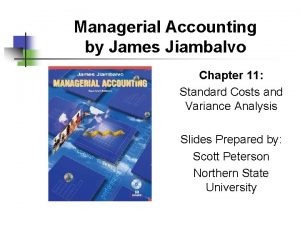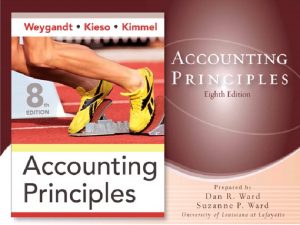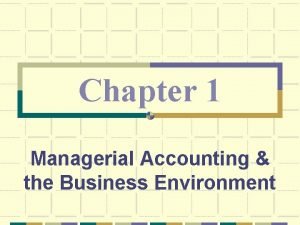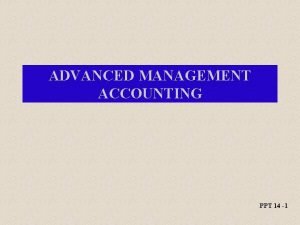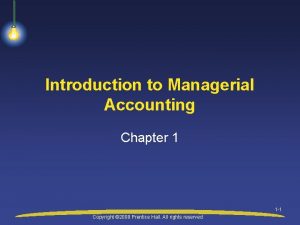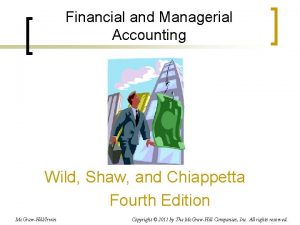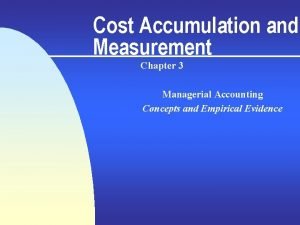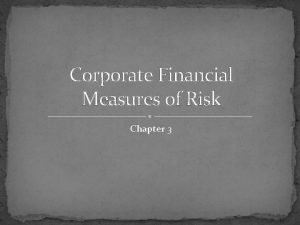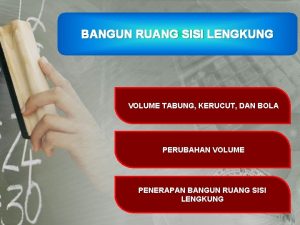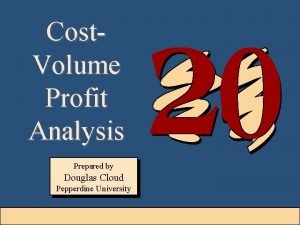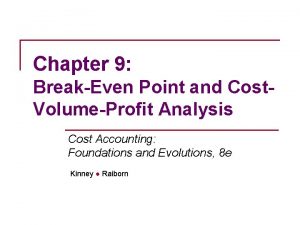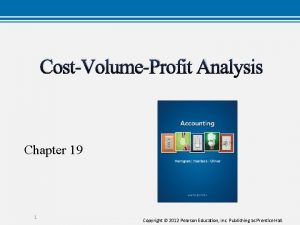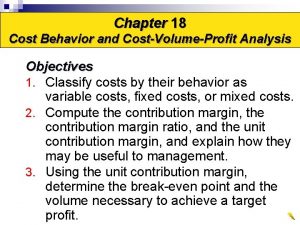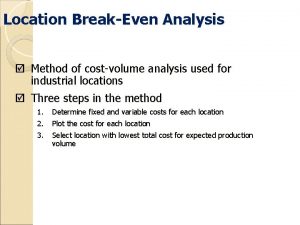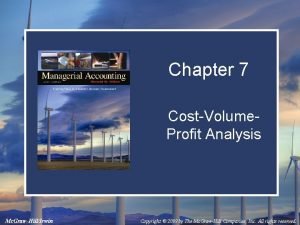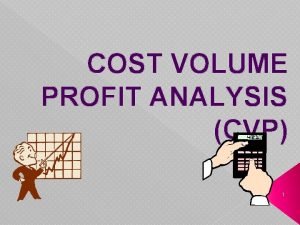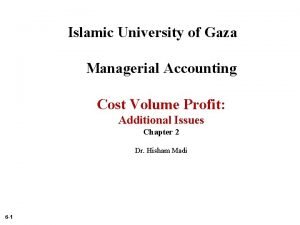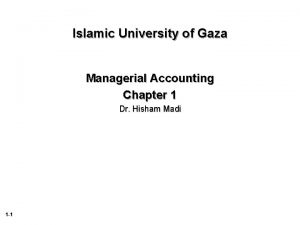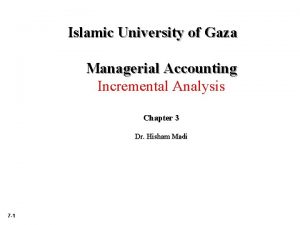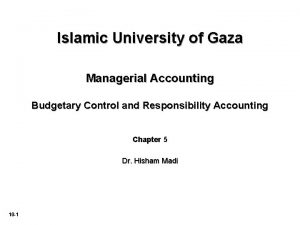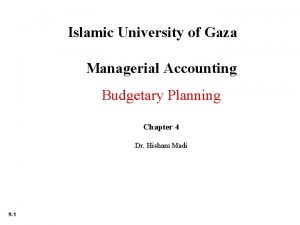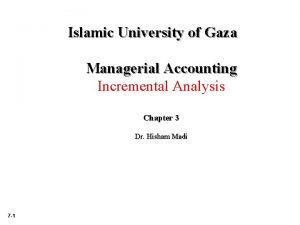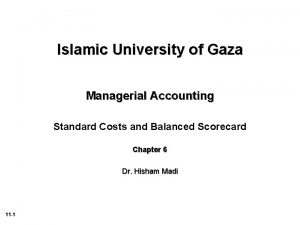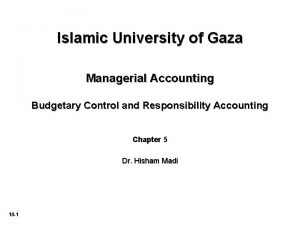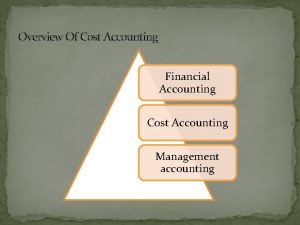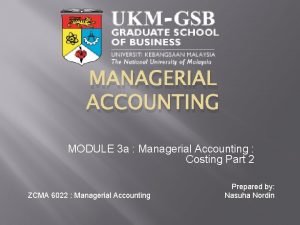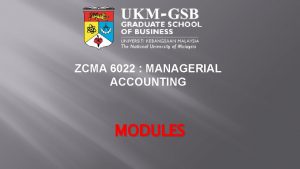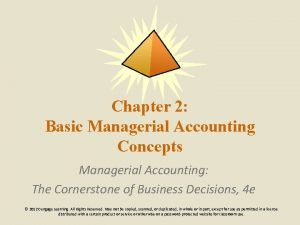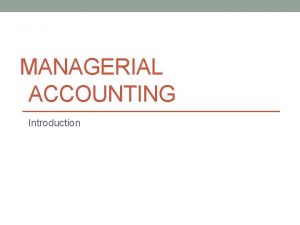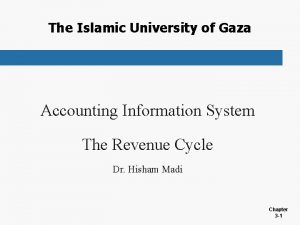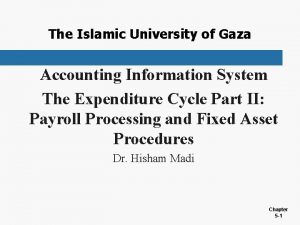Islamic University of Gaza Managerial Accounting Cost Volume































































- Slides: 63

Islamic University of Gaza Managerial Accounting Cost Volume Profit Chapter 2 Dr. Hisham Madi 5 -1

5 -2

Cost Behavior Analysis is the study of how specific costs respond to changes in the level of business activity. 5 -3 u Some costs change; others remain the same. u Helps management plan operations and decide between alternative courses of action. u Applies to all types of businesses and entities. u Starting point is measuring key business activities.

Cost Behavior Analysis is the study of how specific costs respond to changes in the level of business activity. u u 5 -4 Activity levels may be expressed in terms of: ► Sales dollars (in a retail company) ► Miles driven (in a trucking company) ► Room occupancy (in a hotel) Many companies use more than one measurement base.

Cost Behavior Analysis is the study of how specific costs respond to changes in the level of business activity. 5 -5 u Changes in the level or volume of activity should be correlated with changes in costs. u Activity level selected is called activity or volume index. u Activity index: ► Identifies the activity that causes changes in the behavior of costs. ► The activity can be any repetitive event that serves as a measure of output or usage

Cost Behavior Analysis Variable Costs u u 5 -6 Costs that vary in total directly and proportionately with changes in the activity level. ► Example: If the activity level increases 10 percent, total variable costs increase 10 percent. ► Example: If the activity level decreases by 25 percent, total variable costs decrease by 25 percent. Variable costs remain the same per unit at every level of activity.

Cost Behavior Analysis Illustration: Damon Company manufactures tablet computers that contain a $10 camera. The activity index is the number of tablets produced. As Damon manufactures each tablet, the total cost of the camera increases by $10. As part (a) of Illustration shows, total cost of the cameras will be $20, 000 if Damon produces 2, 000 tablets, and $100, 000 when it produces 10, 000 tablets. We also can see that a variable cost remains the same per unit as the level of activity changes. 5 -7

Cost Behavior Analysis Illustration: Damon Company manufactures tablet computers that contain a $10 camera. The activity index is the number of tablets produced. As Damon manufactures each tablet, the total cost of the camera increases by $10. As part (b) of Illustration shows, the unit cost of $10 for the camera is the same whether Damon produces 2, 000 or 10, 000 tablets. 5 -8

Cost Behavior Analysis Variable Costs 5 -9

Cost Behavior Analysis Fixed Costs 5 -10 u Costs that remain the same in total regardless of changes in the activity level. u Per unit cost varies inversely with activity: As volume increases, unit cost declines, and vice versa u Examples: ► Property taxes ► Insurance ► Rent ► Depreciation on buildings and equipment

Cost Behavior Analysis Illustration: Damon Company leases its productive facilities at a cost of $10, 000 per month. Total fixed costs of the facilities will remain constant at every level of activity, as part (a) of Illustration 5 -2 shows. 5 -11

Cost Behavior Analysis Illustration: Damon Company leases its productive facilities at a cost of $10, 000 per month. Total fixed costs of the facilities will remain constant at every level of activity. But, on a per unit basis, the cost of rent will decline as activity increases, as part (b) of Illustration 5 -2 shows. At 2, 000 units, the unit cost per tablet computer is $5 ($10, 000 ÷ 2, 000). When Damon produces 10, 000 tablets, the unit cost is only $1 ($10, 000 ÷ 10, 000). 5 -12

Cost Behavior Analysis Fixed Costs 5 -13 Illustration 5 -2 Behavior of total and unit fixed costs

Cost Behavior Analysis Relevant Range 5 -14 u Throughout the range of possible levels of activity, a straight-line relationship usually does not exist for either variable costs or fixed costs. u Relationship between variable costs and changes in activity level is often curvilinear. u For fixed costs, the relationship is also nonlinear – some fixed costs will not change over the entire range of activities, while other fixed costs may change.

Cost Behavior Analysis Relevant Range 5 -15 Illustration 5 -3 Nonlinear behavior of variable and fixed costs

Cost Behavior Analysis Relevant Range – Range of activity over which a company expects to operate during a year. 5 -16 Illustration 5 -4 Linear behavior within relevant range

Cost Behavior Analysis Mixed Costs 5 -17 u Costs that have both a variable cost element and a fixed cost element. Illustration 5 -5 u Change in total but not proportionately with changes in activity level.

Cost Behavior Analysis High-Low Method 5 -18 u Mixed costs must be classified into their fixed and variable elements. u High-Low Method uses the total costs incurred at both the high and the low levels of activity to classify mixed costs. u The difference in costs between the high and low levels represents variable costs, since only variable costs change as activity levels change.

Cost Behavior Analysis High-Low Method STEP 1: Determine variable cost per unit using the following formula: 5 -19

Cost Behavior Analysis High-Low Method Illustration: Metro Transit Company has the following maintenance costs and mileage data for its fleet of buses over a 6 -month period. Change in Costs (63, 000 - 30, 000) High minus Low 5 -20 (50, 000 - 20, 000) $33, 000 30, 000 = $1. 10 cost per unit

Cost Behavior Analysis High-Low Method STEP 2: Determine the fixed cost by subtracting the total variable cost at either the high or the low activity level from the total cost at that level. 5 -21

Cost Behavior Analysis High-Low Method Maintenance costs are therefore $8, 000 per month plus $1. 10 per mile. This is represented by the following formula: Maintenance costs = Fixed costs + ($1. 10 x Miles driven) Example: At 45, 000 miles, estimated maintenance costs would be: Fixed Variable 5 -22 $ 8, 000 ($1. 10 x 45, 000) 49, 500

Cost Behavior Analysis Scatter plot for Metro Transit Company 5 -23

Byrnes Company accumulates the following data concerning a mixed cost, using units produced as the activity level. (a) Compute the variable and fixed cost elements using the highlow method. (b) Estimate the total cost if the company produces 6, 000 units. 5 -24

(a) Compute the variable and fixed cost elements using the highlow method. Variable cost: ($14, 740 - $11, 100) / (9, 800 - 7, 000) = $1. 30 per unit Fixed cost: $14, 740 - $12, 740 ($1. 30 x 9, 800 units) = $2, 000 or $11, 100 - $9, 100 ($1. 30 x 7, 000) = $2, 000 5 -25

(b) Estimate the total cost if the company produces 6, 000 units. Total cost (6, 000 units): $2, 000 + $7, 800 ($1. 30 x 6, 000) = $9, 800 5 -26

Cost-Volume-Profit Analysis Cost-volume-profit (CVP) analysis is the study of the effects of changes of costs and volume on a company’s profits. 5 -27 u Important in profit planning u Critical factor in management decisions as ► Setting selling prices, ► Determining product mix, and ► Maximizing use of production facilities.

Cost-Volume-Profit Analysis Basic Components Illustration 5 -9 5 -28

Cost-Volume-Profit Analysis Basic Components - Assumptions 5 -29 u Behavior of both costs and revenues is linear throughout the relevant range of the activity index. u All costs can be classified as either variable or fixed with reasonable accuracy. u Changes in activity are the only factors that affect costs. u All units produced are sold. u When more than one type of product is sold, the sales mix will remain constant.

Cost-Volume-Profit Analysis CVP Income Statement u A statement for internal use. u Classifies costs and expenses as fixed or variable. u Reports contribution margin in the body of the statement. ► u 5 -30 Contribution margin – amount of revenue remaining after deducting variable costs. Reports the same net income as a traditional income statement.

Cost-Volume-Profit Analysis CVP Income Statement Illustration: Vargo Video produces a high-definition digital camcorder with 15 x optical zoom and a wide-screen, highresolution LCD monitor. Relevant data for the camcorders sold by this company in June 2014 are as follows. 5 -31

Cost-Volume-Profit Analysis CVP Income Statement Illustration: The CVP income statement for Vargo Video therefore would be reported as follows. 5 -32

Cost-Volume-Profit Analysis Contribution Margin per Unit 5 -33 u Contribution margin is available to cover fixed costs and to contribute to income. u Formula for contribution margin per unit and the computation for Vargo Video are:

Cost-Volume-Profit Analysis Contribution Margin per Unit Vargo’s CVP income statement assuming a zero net income. 5 -34

Cost-Volume-Profit Analysis Contribution Margin per Unit Assume that Vargo sold one more camcorder, for a total of 1, 001 camcorders sold. 5 -35

Cost-Volume-Profit Analysis Contribution Margin Ratio 5 -36 u Shows the percentage of each sales dollar available to apply toward fixed costs and profits. u Formula for contribution margin ratio and the computation for Vargo Video are:

Cost-Volume-Profit Analysis Contribution Margin Ratio Assume current sales are $500, 000, what is the effect of a $100, 000 (200 -unit) increase in sales? 5 -37

Cost-Volume-Profit Analysis Contribution Margin Ratio Assume Vargo Video’s current sales are $500, 000 and it wants to know the effect of a $100, 000 (200 -unit) increase in sales. Illustration 5 -18 5 -38

Cost-Volume-Profit Analysis Break-Even Analysis u Process of finding the break-even point level of activity at which total revenues equal total costs (both fixed and variable). u Can be computed or derived u 5 -39 ► from a mathematical equation, ► by using contribution margin, or ► from a cost-volume profit (CVP) graph. Expressed either in sales units or in sales dollars.

Break-Even Analysis Mathematical Equation Break-even occurs where total sales equal variable costs plus fixed costs; i. e. , net income is zero Computation of break-even point in units. 5 -40

Break-Even Analysis Contribution Margin Technique u At the break-even point, contribution margin must equal total fixed costs (CM = total revenues – variable costs) u 5 -41 Break-even point can be computed using either contribution margin per unit or contribution margin ratio.

Break-Even Analysis Contribution Margin Technique u 5 -42 When the BEP in units is desired, contribution margin per unit is used in the following formula which shows the computation for Vargo Video:

Break-Even Analysis Contribution Margin Technique u 5 -43 When the BEP in dollars is desired, contribution margin ratio is used in the following formula which shows the computation for Vargo Video:

Break-Even Analysis Graphic Presentation Because this graph also shows costs, volume, and profits, it is referred to as a cost-volume-profit (CVP) graph. 5 -44

Lombardi Company has a unit selling price of $400, variable costs per unit of $240, and fixed costs of $180, 000. Compute the break-even point in units using (a) a mathematical equation and (b) contribution margin per unit. Illustration 5 -19 5 -45 Sales - Variable Costs - Fixed Costs = $400 Q - $240 Q - $180, 000 = $160 Q - $180, 000 Q = 1, 125 units Net Income 0

Lombardi Company has a unit selling price of $400, variable costs per unit of $240, and fixed costs of $180, 000. Compute the break-even point in units using (a) a mathematical equation and (b) contribution margin per unit. Fixed Costs $180, 000 5 -46 ÷ ÷ Contribution Margin per Unit = Break-Even Point in Units $160 = 1, 125 units

Cost-Volume-Profit Analysis Target Net Income u Level of sales necessary to achieve a specified income. u Can be determined from each of the approaches used to determine break-even sales/units: u 5 -47 ► from a mathematical equation, ► by using contribution margin, or ► from a cost-volume profit (CVP) graph. Expressed either in sales units or in sales dollars.

Cost-Volume-Profit Analysis Target Net Income Sales necessary to achieve a specified level of income. Mathematical Equation Formula for required sales to meet target net income. 5 -48

Target Net Income Mathematical Equation Using the formula for the break-even point, simply include the desired net income as a factor. 5 -49

Target Net Income Contribution Margin Technique To determine the required sales in units for Vargo Video: 5 -50

Target Net Income Contribution Margin Technique To determine the required sales in dollars for Vargo Video: 5 -51

Cost-Volume-Profit Analysis Margin of Safety 5 -52 u Difference between actual or expected sales and sales at the break-even point. u Measures the “cushion” that management has if expected sales fail to materialize. u May be expressed in dollars or as a ratio. u Assuming actual/expected sales are $750, 000:

Cost-Volume-Profit Analysis Margin of Safety u Computed by dividing the margin of safety in dollars by the actual or expected sales. u Assuming actual/expected sales are $750, 000: Illustration 5 -29 u 5 -53 The higher the dollars or percentage, the greater the margin of safety.

Zootsuit Inc. makes travel bags that sell for $56 each. For the coming year, management expects fixed costs to total $320, 000 and variable costs to be $42 per unit. Compute the following: (a) break-even point in dollars using the contribution margin (CM) ratio; (b) the margin of safety assuming actual sales are $1, 382, 400; and (c) the sales dollars required to earn net income of $410, 000. 5 -54

Compute: (a) break-even point in dollars using the contribution margin (CM) ratio. Unit selling price Unit variable costs - 42 Contribution margin per unit 14 Unit selling price 56 Contribution margin ratio Fixed costs Contribution margin ratio Break-even sales in dollars 5 -55 $56 25% $320, 000 25% $1, 280, 000

Compute: (b) the margin of safety assuming actual sales are $1, 382, 400. Actual (Expected) sales $ 1, 382, 400 Break-even sales - 1, 280, 000 Margin of safety in dollars Actual (Expected) sales Margin of safety ratio 5 -56 102, 400 1, 382, 400 7. 4%

Compute: (c) the sales dollars required to earn net income of $410, 000. Fixed costs Target net income $ 320, 000 + 410, 000 730, 000 5 -57 Contribution margin ratio 25% Required sales in dollars $2, 920, 000

Comprehensive Mabo Company makes calculators that sell for $20 each. For the coming year, management expects fixed costs to total $220, 000 and variable costs to be $9 per unit. Compute: a) Break-even point in units using the mathematical equation. b) Break-even point in dollars using the contribution margin (CM) ratio. c) Margin of safety percentage assuming actual sales are $500, 000. d) Sales required in dollars to earn net income of $165, 000. 5 -58

Comprehensive Mabo Company makes calculators that sell for $20 each. For the coming year, management expects fixed costs to total $220, 000 and variable costs to be $9 per unit. Compute break -even point in units using the mathematical equation. $20 Q = $9 Q + $220, 000 + $0 $11 Q = $220, 000 Q = 20, 000 units 5 -59

Comprehensive Mabo Company makes calculators that sell for $20 each. For the coming year, management expects fixed costs to total $220, 000 and variable costs to be $9 per unit. Compute break-even point in dollars using the contribution margin (CM) ratio. Contribution margin per unit = $20 Contribution margin ratio = $11 / $9 $20 = 55% Break-even point in dollars = $220, 000 = $400, 000 5 -60 = $11 / 55%

Comprehensive Mabo Company makes calculators that sell for $20 each. For the coming year, management expects fixed costs to total $220, 000 and variable costs to be $9 per unit. Compute the margin of safety percentage assuming actual sales are $500, 000. Margin of safety = 5 -61 $500, 000 - $400, 000 $500, 000 = 20%

Comprehensive Mabo Company makes calculators that sell for $20 each. For the coming year, management expects fixed costs to total $220, 000 and variable costs to be $9 per unit. Compute the sales required in dollars to earn net income of $165, 000. $20 Q = $9 Q + $220, 000 + $165, 000 $11 Q = $385, 000 Q = 35, 000 units x $20 = $700, 000 required sales 5 -62

“Copyright © 2012 John Wiley & Sons, Inc. All rights reserved. 5 -63
 Managerial accounting and cost concepts
Managerial accounting and cost concepts Relevant range managerial accounting
Relevant range managerial accounting Chapter 1 managerial accounting and cost concepts
Chapter 1 managerial accounting and cost concepts Cost structure refers to the relative proportion of
Cost structure refers to the relative proportion of Sınıfı
Sınıfı Pakimires
Pakimires Bil soruyu bas gaza
Bil soruyu bas gaza Gaza strip map
Gaza strip map Gaza strip map
Gaza strip map Mapa franja de gaza
Mapa franja de gaza Palestina e israel mapa
Palestina e israel mapa Gaza central desalination plant
Gaza central desalination plant Dzsenin
Dzsenin Oshbe
Oshbe Islamic university college
Islamic university college Cost theory and estimation
Cost theory and estimation Estimation of cost function in managerial economics
Estimation of cost function in managerial economics Management accounting scope
Management accounting scope Managerial accounting chapter 5
Managerial accounting chapter 5 Managerial accounting chapter 13 solutions
Managerial accounting chapter 13 solutions Managerial accounting chapter 9
Managerial accounting chapter 9 Managerial accounting chapter 2 solutions
Managerial accounting chapter 2 solutions Jiambalvo managerial accounting
Jiambalvo managerial accounting How to calculate cost of goods transferred out
How to calculate cost of goods transferred out Prime cost formula
Prime cost formula How managerial accounting adds value to the organization
How managerial accounting adds value to the organization Chapter 1 managerial accounting
Chapter 1 managerial accounting Financial and managerial accounting weygandt kimmel kieso
Financial and managerial accounting weygandt kimmel kieso Managerial accounting chapter 7
Managerial accounting chapter 7 Accounting and the business environment
Accounting and the business environment Chapter 1 managerial accounting
Chapter 1 managerial accounting What is cma
What is cma Accounting principles and concepts
Accounting principles and concepts Managerial accounting james jiambalvo
Managerial accounting james jiambalvo Scope of accounting
Scope of accounting Manufacturing accounting basics
Manufacturing accounting basics Distinguishing features of managerial accounting
Distinguishing features of managerial accounting Managerial accounting and the business environment
Managerial accounting and the business environment Advanced cost and management accounting ppt
Advanced cost and management accounting ppt Chapter 1 managerial accounting
Chapter 1 managerial accounting Financial and managerial accounting wild
Financial and managerial accounting wild Managerial accounting chapter 3
Managerial accounting chapter 3 Dol managerial accounting
Dol managerial accounting What is the volume of blood pumped per minute
What is the volume of blood pumped per minute Stroke volume normal
Stroke volume normal Volume of solute divided by volume of solution * 100
Volume of solute divided by volume of solution * 100 Closing volume vs residual volume
Closing volume vs residual volume Volume kerucut = .....x volume tabung *
Volume kerucut = .....x volume tabung * Large volume parenterals
Large volume parenterals Cost volume profit
Cost volume profit Margin of safety in units formula
Margin of safety in units formula Chapter 3 cost volume profit analysis
Chapter 3 cost volume profit analysis Unit contribution margin equation
Unit contribution margin equation Cost volume
Cost volume Cost volume
Cost volume Locational break even analysis example
Locational break even analysis example Location cost volume analysis example
Location cost volume analysis example Cost volume profit analysis graph
Cost volume profit analysis graph Bep in rm
Bep in rm Market area plant strategy
Market area plant strategy Cost accumulation and cost assignment
Cost accumulation and cost assignment Cost accumulation and cost assignment
Cost accumulation and cost assignment Manufacturing cost vs non manufacturing cost
Manufacturing cost vs non manufacturing cost Job costing vs process costing examples
Job costing vs process costing examples
